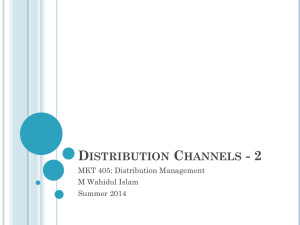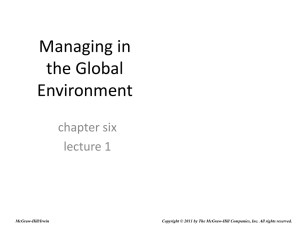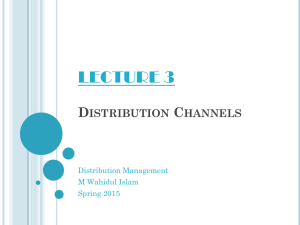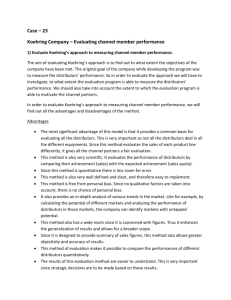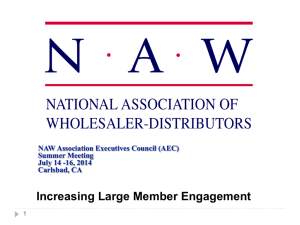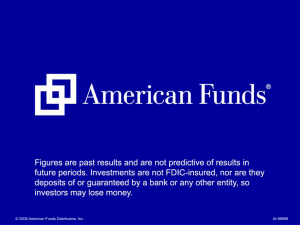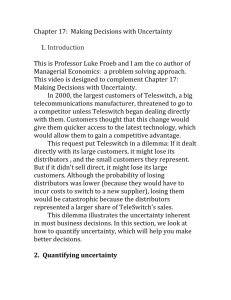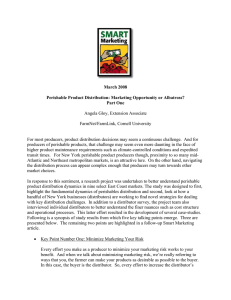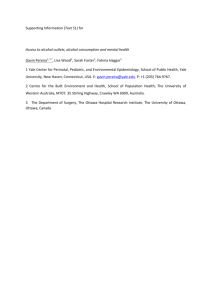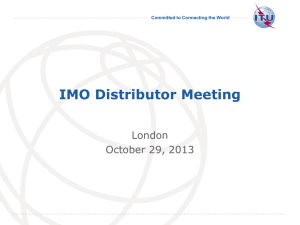File
advertisement
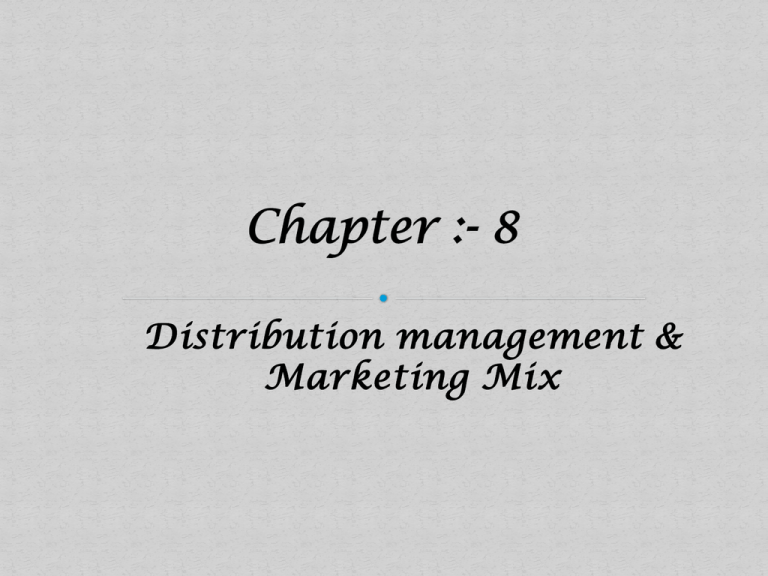
Distribution management & Marketing Mix Distribution refers to bringing the product to the market and giving it to the final consumer According to Mossmam & Norton “distribution is the operation which creates time,place & form utility through the movement of goods and persons from one place to another”. Are sets of interdependent organizations involved in the process of making a product or service available for use or consumption Right product in Right quantity in Right condition at the Right time and Right place for the Right customer at Right cost Are intermediaries or middlemen Exist because producers cannot reach all their consumers Multiply reach and provide efficiency to the marketing process Facilitate smooth flow and create time, place and possession utilities Have the core competence and reach Provide contact, experience, specialisation and scales of operation 5 Product Place Price Promotion Distribution channels help in the ‘place’ aspect of the marketing mix Distribution provides place, time and possession utility to the consumer 6 Consumer wants to buy a tube of toothpaste Made available at a retail outlet close to her residence – place Made available at 8 pm on a Tuesday evening when she wants it – time She can pay for the toothpaste and take it away – possession The company distribution function has made all this possible. The situation would be similar if a customer wants to buy a refrigerator or medicines or even an electric motor 7 Spatial discrepancy :- the difference between the location of a producer and the location of widely scattered markets Temporal discrepancy:- a situation that occurs when a product is produced but a customer is not ready to buy it Need for breaking the bulk Need for assortment Derived from the corporate strategy and the marketing strategy Steps for designing the distribution strategy are: Defining customer service levels Distribution objectives and steps Set of activities The distribution organization Key performance indicators Critical success factors 9 Defined by the nature of the industry, the products, competition and market shares. Affordability also decides the service level It should at least match competition. Customer expectations have no limit 10 Influenced by the customer expectations Defines the extent of time, place and possession utility which the customer can expect out of the channel network Set of activities…. 11 Manner in which the company and its marketing channels go about achieving the customer service levels Some of these steps could be: Sales forecasts Despatch plans Market coverage beat plans Journey plans for service engineers Collection of sales proceeds Carrying out promotional activities The company also decides as to who is to perform which task Organization…. 12 Extent of company support and outsourcing to be decided Budget for the cost of the distribution effort Select suitable channel partners – C&FAs, and distributors Setting clear objectives for the partners Agree on level of financial commitments by the channel partners. Policy and procedure.. 13 Define policy and implementation guidelines through Operating Manuals Policy guidelines include Code of conduct for channel members System for redressal of complaints Any additional subsidies etc Handling institutional business Service policy for engineering products KPIs…. 14 For measurement of effectiveness. Some of these could be: Consistent achievement of targets by product groups, periods and territories Achievement of market shares Achievement of profitability Zero complaints from customers No stock returns Ability to handle emergencies and sudden spurts in demand 15 For measurement of effectiveness. Some of these could be: Balanced sales achievement during a period – no period end skews Market coverage with ready stocks Excellent management of accounts receivables Minimize losses on account of stock-outs Minimize damages to products CSFs… 16 The distribution strategy also needs the support and encouragement of top management to succeed Some of the CSFs could be: Clear, transparent and unambiguous policy and procedure Serious commitment of the channel partners Fairness in dealings Clearly defined customer service policy High level of integrity Equitable distribution at times of shortage Timely compensation of channel partners 17 C&FAs and CSAs Distributors, dealers, stockists, value-added re- sellers Agents and brokers Franchisees Electronic channels Wholesalers Retailers 18 C&FA: carrying and forwarding agent and C&SA: carrying and selling agent – both are on contract with a company Both are transporters who work between the company and its distributors Collect products from the company, store in a central location, break bulk and despatch to distributors against indents Goods belong to the company C&SA also sells the goods on behalf of the company but remits proceeds after sale 19 Name denotes the extent of re-distribution done by them Distributors invest in the products – buy products from the company Are on commission, margins or mark-up May or may not get credit – but extend credit Distributors cover the markets as per a beat plan. All others merely finance the business. Distributors could be exclusive for a company Agents bring buyer and seller together 20 Operate out of the main markets Deal with a number of company products of their choice Are not on contract with any company Sell to other wholesalers, retailers and institutions Negotiate about 15 days credit from company distributors – also provide credit to their customers Operate on high volumes and low margins 21 The final contact with consumers Operate out of their shops and sell a large assortment and variety of goods Located closest to consumers Buy from company, distributors or wholesalers Highest margins in the network Provide personalised services to their customers 22 Customers may also direct from company sales force Producer Producer Agent/middleman Industrial Distributor Industrial Distributor Industrial Customer Industrial Customer 23 Retailers may also direct from company sales force Producer Producer Producer Distributor Distributor Wholesaler Retailer Retailer Retailer Customer / consumer Customer/ Consumer Customer/ Consumer 24 Determines the intensity of the distribution Intensity decides the service level provided Types of distribution intensity: Intensive Selective Exclusive 25 Intensive distribution:- a form of distribution aimed at having a product available in every outlet where target customers might want to buy it. Selective distribution:- a form of distribution achieved by screening dealers to eliminate all but a few in any single area exclusive distribution:- a form of distribution that establishes one or a few dealers within a given area Intensive: distribution through every reasonable outlet available – FMCG Selective: multiple, but not all outlets in the market – pharma, frozen food Exclusive: may be only one outlet in a market - car dealers 27 Strategy is to make sure that the product is available in as many outlets as possible Preferred for consumer, pharmaceutical products and automobile spares 28 A few select outlets will be permitted to keep the products Outlets selected in line with the image the company wants to project Preferred for high value products Tanishque jewelry Keeps distribution costs lower 29 Highly selective choice of outlets – may be even one outlet in an entire market Could include outlets set up by companies – Titan, Bata Producer wants a close watch and control on the distribution of his products. Channel strategy… 30
